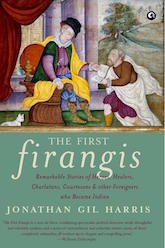The First Firangis: How to Be Authentically Indian
Jonathan Gil Harris
|
|
Much has been written about the British who came to India during the high noon of the Raj. As I know from my childhood in Kolkata, they were usually strongly discouraged from becoming Indian—going native or becoming jungly, as it used to be said. Those who came to India during the early years of the Raj have become well known as “white Mughals” as a result of William Dalrymple’s highly acclaimed book. They did indeed become Indian, and embraced Indian culture. In his new book The First Firangis, Jonathan Gil Harris tells the stories of foreigners, or firangis, who came to India before the British exercised any authority. Often fleeing poverty or persecution, they had to accommodate themselves to the climate, culture, cuisine and language of the part of India they found themselves in. They lived under Indian, not colonial, rule. Harris tells fascinating stories of extraordinary men and women, and their lives lead him to consider what becoming Indian means. One of the most fascinating firangis is an Englishman called Thomas Coryate, who became a fakir, a travelling mendicant. Coryate had served in the court of King James I as a sort of jester, renowned for never-ending oration in which he dodged from language to language. Odd Tom, as he became known, in part because he was very small and had a peculiarly ugly face, was a great traveller. He wrote an account of a European tour called Crudities, which gave him a taste for being a celebrity. Odd Tom’s travels eventually took him to India. Dressed as a fakir in Ajmer, he managed to deliver an oration in the manner of afakir to Mughal emperor Jahangir. Eventually, starving and burning with fever, Odd Tom died in Surat after a night carousing with young officers of the East India Company.
Italian writer and traveller Niccolò Manucci ran away from Venice and appears to have become the servant of an English lord who, like Odd Tom, wanted to meet the Mughal emperor, this time Shah Jahan, but died travelling from Agra to Delhi. Manucci was left stranded. The Italian was robbed by two villainous English firangis who were part-time mercenaries in the pay of the emperor and part-timedakaits (bandits). He then spent the next 30 years drifting about India. Eventually, Manucci went to see an old friend in Pondicherry (now Puducherry) and told him he had had enough of India. But the friend persuaded him that he was now so Indian he would find it very difficult to settle down in Europe, so he stayed on in south India, practising as a Siddha vaidya, or traditional physician. A distinguished Portuguese physician, Garcia De Orta, who made various journeys to India as a ship’s doctor, eventually stayed on too. He appears to have been afraid that his Jewish identity, which he concealed by taking a Christian name and attending church, would be uncovered in Portugal, where Jews were being persecuted. In India he took to practising as a hakim, or traditional physician, and was held in such high esteem that he was buried in the cathedral in Goa. But the Inquisition, by then established in Goa too, eventually got him. After his death, his Jewish identity was revealed and he was disinterred and incinerated. His ashes were thrown in the Mandovi river. The Englishman Thomas Stephens was a Jesuit who was ordained in Goa. The Jesuits had decided that Christianity could best be spread by a policy of accommodation or inculturation. This policy permitted Brahmin converts to wear their sacred threads and allowed casteism to be practised in the Church. Stephens wholeheartedly supported this policy. He didn’t go so far as fellow Jesuit Roberto De Nobili, an Italian missionary in Tamil Nadu who wore the Brahmanical sacred thread, shaved his head and dressed like a Brahmin. But Stephens did immerse himself in Hindu tradition by writing an epic poem about the history of the world, from creation to the coming of Christ, in Marathi. He wrote it in the style of a Purana and called it Kristapurana. Harris tells us that there were very few firangi women in India during those first 200 years of Mughal rule. There is very little hard information in the stories of two women that he tells because the stories of men dominate the archives. Writing of Bibi Juliana Firangi, the begum of Lahore, Harris admits that we know “next to nothing” about the details of her life. “She appears to have been an Armenian who married a high-ranking courtier, lived in Akbar’s harem, gave birth to two sons and died young.” In his description of her life in the harem, Harris says she would not have been entirely confined to it. Given Akbar’s religious tolerance, she would probably have been allowed to go to a church on Sunday. Harris is an academic who lived for 23 years in the US but has now settled in New Delhi, where he is professor of Shakespeare at Ashoka University. He defines a firangi as “a migrant to India who has somehow become Indian yet continues to be marked as alien”. There are short chapters dispersed throughout the book in which he discusses his own experiences of becoming Indian and being a latter-dayfirangi. That experience and his study of the earlier firangis have led him to think about the definition of an authentic Indian. His conclusion is that all Indians are firangis because, as he sees it, there have been so many migrations to India that every Indian must ultimately have some foreign ancestry. Harris makes being Indian a very malleable concept, saying, “The Indian is always becoming something new and is constantly being negotiated and transformed in a multitude of ways because of unexpected conversations between local traditions and foreign elements.” This is not a view that would appeal to Indians who argue that their identity is based on what many scholars see as an ancient culture still surviving today. Perhaps Harris is overstating the Indian culture’s syncretism. There has to be a mainstream that firangis’ cultures flow into, otherwise there would be no authentic Indian. Mark Tully has authored several books, including Non Stop India and India: The Road Ahead
Mark Tully | 21 Feb 2015 | LiveMint Jonathan Gil Harris |


